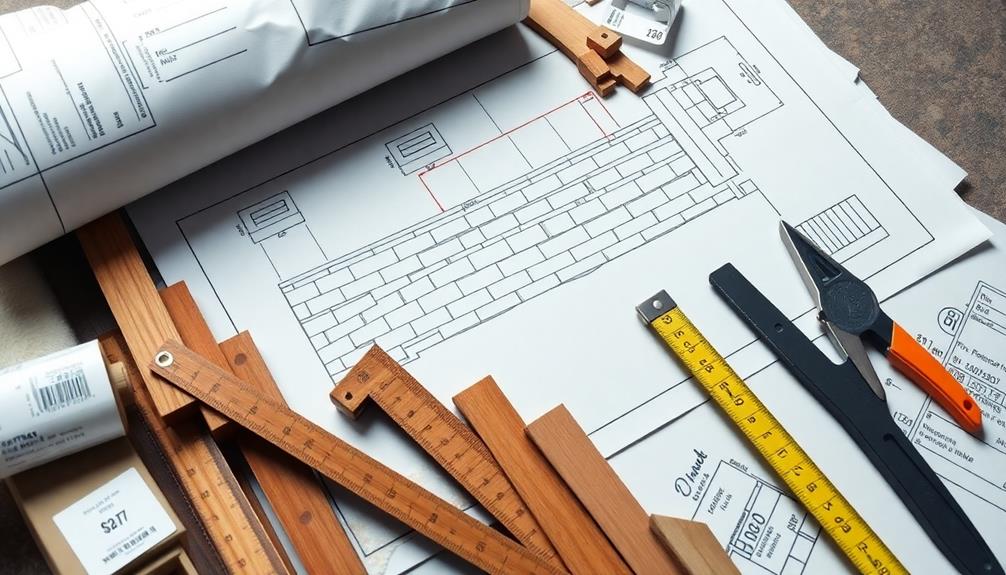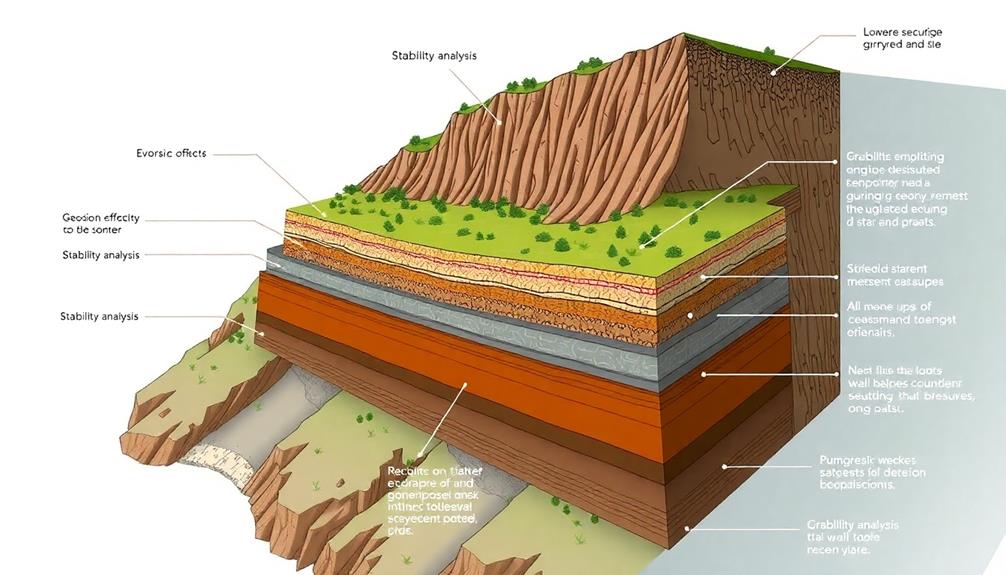Understanding cost estimation for retaining walls is crucial to guarantee financial feasibility and resource efficiency throughout construction. This process involves an intricate assessment of material costs, labor expenses, and site-specific challenges, such as soil stability and geological conditions. Effective cost estimation enhances project planning, enabling stakeholders to choose durable materials aligned with sustainability goals, reducing unexpected expenses, and ensuring compliance with building codes. Accurately estimating costs also strengthens stakeholder confidence by establishing a shared vision and facilitating collaborative efforts. By examining every detail, one can achieve a more complete approach to retaining wall project planning and execution.
Table of Contents
ToggleWalls Contractor Highlights
- Accurate cost estimation ensures the financial feasibility and efficient resource allocation for retaining wall construction projects.
- It helps select durable, high-quality materials, enhancing the structural integrity and longevity of retaining walls.
- Understanding cost factors aids in making informed decisions and avoiding unexpected expenses during the project.
- Proper estimation aligns stakeholder priorities, fosters trust, and strengthens community collaboration toward shared infrastructure goals.
- It supports compliance with building codes and contributes to the overall sustainability and resilience of retaining walls.
Definition of Cost Estimation

Cost estimation in the context of retaining walls involves an extensive comprehension of various key components, including labor, materials, equipment, and site conditions, each playing a critical role in ensuring an accurate projection of costs. Proper estimation helps in planning for various functionalities such as preventing erosion and creating usable gardening space, which are essential services of retaining walls.
Key Components Explained
Any thorough analysis of retaining wall projects involves an understanding of cost estimation—a foundational component in project planning and budgeting. This essential function aids in determining the financial feasibility and resource allocation for constructing retaining walls. It goes beyond simple arithmetic, requiring an in-depth evaluation of multiple, interrelated factors.
These factors include material costs, labor expenses, site conditions, and potential geological challenges, forming a cohesive budgetary framework.
Understanding what constitutes cost estimation requires dissecting each component meticulously. Material costs account for the bulk of the budget, as various types of materials, such as concrete, stone, or timber, influence the final price based on strength and durability needs.
Labor expenses further affect cost, determined by both the workforce's expertise and the project timeline's demands. Site conditions, including soil type, slope, and weather considerations, necessitate customized approaches, potentially altering standard procedures and costs. Additionally, unforeseen geological challenges could arise, potentially driving costs up through necessary adjustments and adaptations.
Estimation Methods Overview
In the domain of project planning and budgeting, precisely estimating costs is a critical step that guarantees the success and viability of retaining wall projects. Cost estimation serves as the foundational phase where key financial parameters are delineated, thus allowing stakeholders to allocate resources effectively while minimizing the risk of unforeseen expenditures.
Through an extensive evaluation, cost estimation integrates various methodologies, such as detailed itemized assessments, which meticulously break down each component's expenses, forecasting techniques that apply statistical models for future cost predictions, and parametric estimates utilizing historical data to derive cost indicators.
For communities invested in the development of infrastructure, understanding these methods fosters a collective sense of assurance, enabling stakeholders to engage meaningfully with the process. Accurate cost estimation not only aids in crafting realistic budgets but also aligns project aspirations with financial capabilities, fostering an environment where shared economic objectives can be achieved.
Such methodologies not only provide a strategic lens into project management but enrich collaborative efforts, ensuring that each component's cost implications are transparently communicated. This clarity cultivates trust within the community as individuals work together toward advancing their infrastructural goals harmoniously and effectively.
Influence of Materials
Material selection plays a pivotal role in the cost estimation of retaining walls, substantially influencing the overall budget and long-term project sustainability. The choice between materials such as concrete, timber, stone, or brick encompasses not only immediate pricing variances but also impacts on durability and maintenance expenditures over time.
For instance, while concrete blocks may offer a cost-effective solution upfront with their wide availability and robustness, natural stone imparts a timeless aesthetic appeal, albeit at a higher initial cost. Each material poses unique benefits and potential drawbacks depending on site-specific conditions such as soil type, load requirements, and environmental exposure.
Key to maintaining project alignment with financial and sustainability goals is a thorough analysis of material properties and their compatibility with the intended wall function. Considerations of cost include both the direct costs associated with the purchase and installation of materials, as well as indirect costs related to long-term maintenance, repair needs, and environmental adaptability.
The strategic selection not only determines the financial feasibility of construction but also underpins the enduring service life of the structure. By understanding these material influences, stakeholders can make informed decisions, fostering a sense of shared purpose and confidence in project outcomes.
Benefits

Implementing effective cost estimation for retaining walls provides significant benefits, predominantly by elevating project planning and guaranteeing an efficient allocation of resources. Through this process, project managers can select appropriate materials such as boulder retaining walls, which offer durability and a natural appearance.
This meticulous approach empowers project managers to manage budgets effectively, reducing the likelihood of exceeding financial constraints and thereby minimizing unexpected expenses that could derail the project timeline. Retaining wall specialists ensure compliance with local building codes, which further enhances project planning.
Additionally, accurate cost estimation plays a pivotal role in ensuring that high-quality materials are selected and utilized, thus contributing to the structural integrity and longevity of the retaining wall.
Enhances Project Planning
Accurate cost estimation for retaining walls vastly enhances project planning by providing a clear financial roadmap. This foresighted approach allows for the anticipation of expenses, facilitating resource allocation and permitting a comprehensive understanding of financial requirements throughout the duration of the project. By establishing a clearly defined budgetary framework, stakeholders are afforded peace of mind, fostering a collaborative environment grounded in transparency and strategic foresight.
Moreover, cost estimation encourages a systematic examination of all aspects of the project, from material selection to labor costs and time allocation. This detailed insight, in turn, enhances communication between engineers, architects, contractors, and clients, ensuring all parties are aligned with the project's scope and goals. Empowering project managers with reliable estimates, the planning phase shifts smoothly into execution, minimizing potential setbacks that could arise from unforeseen financial discrepancies.
This proactive approach strengthens stakeholder confidence since they become part of a community working towards common objectives and shared success. Through meticulous planning rooted in accurate cost estimation, projects are better equipped to adapt to challenges while maintaining their trajectory toward successful completion. The robustness of this planning foundation lays the groundwork for achieving project goals efficiently and effectively.
Manages Budget Effectively
Building on the foundation of enhanced project planning, effectively managing a budget becomes a natural progression. By establishing a detailed cost estimate for building retaining walls, stakeholders can control financial resources with increased precision. This approach provides a comprehensive understanding of allocation requirements, enabling project managers and clients to anticipate financial impacts throughout the wall's construction. In doing so, organizations assure themselves of steering clear of financial strain by staying aligned with predetermined financial boundaries.
Furthermore, cost estimation promotes financial discipline, fostering an environment where every expenditure is objectively assessed against expected outcomes. This strategic foresight not only conserves resources but creates a shared sense of ownership among team members, who recognize their part in safeguarding the project's fiscal health. As a result, stakeholders shift from passive participants to active partners, reinforcing their shared vision.
Ultimately, when budgets are managed effectively, it strengthens trust between all parties involved, cultivating a collective commitment to project success. With every dollar accounted for and responsibly spent, clients can appreciate the collaborative effort that transforms estimated costs into a well-executed, tangible structure. Cost estimation therefore is integral in nurturing relationships and securing a foundation of trust and collaborative achievement within the community.
Avoids Unexpected Expenses
A meticulous cost estimation process serves as a pivotal mechanism in circumventing unexpected expenses during the construction of retaining walls. By thoroughly evaluating all potential costs, such as labor, materials, and equipment, project stakeholders can effectively anticipate and prepare for financial demands.
A detailed cost estimation not only outlines a clear budgetary framework but also provides an extensive understanding of potential financial contingencies, ensuring that surprises are minimized and financial plans are adhered to.
Moreover, incorporating precise cost estimation fosters an environment of confidence and security within the project team and stakeholders, solidifying their sense of belonging in a well-managed operation. Details such as specific materials required, specialized machinery, or unforeseen site conditions can dramatically impact expenses if not adequately accounted for at the project's outset.
By foreseeing these variables, cost estimation functions as a safeguard against budget overruns that can strain resources and cause project delays. This systematic approach to cost planning underscores the importance of strategic foresight, empowering teams to allocate resources efficiently and helping to avoid the stress and financial strain associated with unexpected costs.
Indeed, understanding and implementing thorough cost estimations are essential for successful retaining wall construction projects.
Ensures Quality Materials
Investing in quality materials is not just a decision but a commitment that pays dividends in the longevity and structural integrity of retaining walls. When one sets out on the journey of building or repairing these essential structures, it becomes paramount to rely on materials that are resilient against the natural elements and time.
Cost estimation plays a pivotal role in ensuring these materials are procured, providing a framework that prioritizes higher-grade substances without compromising the budget.
High-quality materials, though potentially more expensive upfront, offer unmatched durability and sustainability, minimizing future repairs and replacements. They also comply with industry standards, which reinforce safety and performance, resonating with a community that values secure living environments. When thorough cost estimation is employed, it distinguishes between initial price point and enduring value, fostering informed choices.
The interconnection between cost estimation and material quality fosters a sense of belonging among those engaged in the project, from contractors to homeowners, establishing trust in its outcomes. Extensively understanding this process empowers decision-makers to create retaining walls that stand the test of time and integrate seamlessly within their surroundings, providing strength and security for years to come.
Geological Impact Consideration

When estimating the cost of retaining walls, it is essential to account for geological impact considerations, primarily focusing on soil stability factors, drainage system design, and foundation material selection, as these elements markedly influence both the structural integrity and the financial outlay. The table below highlights the interconnected nature of these elements, emphasizing their critical role in guaranteeing the longevity and effectiveness of retaining walls:
| Consideration | Impact on Stability | Cost Implication |
|---|---|---|
| Soil Stability | Determines wall reinforcement | Moderate to high |
| Drainage System | Prevents water accumulation | Moderate |
| Foundation Material | Ensures durability | High |
Careful integration of these factors into the planning and design phases can lead to optimized resource allocation, ultimately balancing the project's technical requirements with its budgetary constraints.
Soil Stability Factors
Understanding the geological impact on soil stability is critical for accurate cost estimation of retaining walls. Soil stability greatly influences the design and construction complexities, which in turn affect material and labor costs.
Various geological factors, such as soil type, its cohesion, internal friction angle, and moisture content, play pivotal roles in determining the stability of the soil where a retaining wall is to be built. Clayey soils, for example, might need specific reinforcement techniques due to their expansion and contraction tendencies, while sandy soils could require different measures due to their vulnerability to erosion.
Moreover, the presence of rock layers, slope gradient, and natural or human-induced seismic activities further necessitate detailed geological surveys to gauge soil behavior. Understanding these factors allows engineers to design retaining walls that are not only structurally sound but also cost-effective.
Accurate soil analysis guarantees that potential risks, such as landslides or wall failure, are mitigated, leading to reliable construction outcomes. Consequently, integrating broad soil stability assessments into the planning phase reinforces community safety and shared environmental responsibilities, fostering collaboration among stakeholders while addressing common regional challenges related to ground stability.
Drainage System Design
Properly designed drainage systems are integral to the longevity and stability of retaining walls, where geological impact must be meticulously considered. Effective drainage mitigates hydrostatic pressure—a critical factor that influences wall integrity. This pressure can induce soil and water weight burdens, leading to structural failure if not carefully managed.
Tailoring drainage strategies to the specific geological characteristics of a site requires understanding the interplay between water movement and soil and rock types. Permeable soils, for instance, may permit rapid water drainage but can increase erosion concerns, while more compact soils necessitate alternative drainage solutions, such as weep holes or French drains, to combat water accumulation.
Design considerations extend beyond merely diverting water, encompassing the examination of seasonal weather patterns and geological shifts. Predictive assessment tools aid in modeling water behavior over time, ensuring that the drainage design remains adaptable to both expected and unexpected environmental changes.
Engaging with the community of geotechnical experts, civil engineers, and landscape architects creates a collaborative environment that nurtures the development of ideal drainage mechanisms, safeguarding shared investments. Retaining walls serve not just a practical function in land management but foster a greater sense of security, highlighting the collective commitment to sustainable and resilient infrastructure development.
Foundation Material Selection
Evaluating the geological conditions of a site with an emphasis on foundation material selection is paramount for ensuring the stability and durability of retaining walls. This process involves a detailed analysis of subsurface characteristics, including soil composition, density, and moisture content, which can profoundly influence the choice of foundation materials. The selection is not merely a technical deliberation but a foundational element of the wall design, offering assurance that the structure can withstand environmental pressures and contribute to the community's lasting infrastructure.
Choosing appropriate materials necessitates understanding the geological impact on construction methods. For instance, expansive soils may require deep foundation systems such as drilled piers or piles to mitigate movement and settlement. Conversely, stable, cohesive soils may allow for more economical shallow foundations. It's crucial to contemplate the geotechnical report's findings, as it guides the appropriate engineering strategies to mitigate risks associated with potential landslides, erosion, or seismic activity, which in turn affects long-term maintenance costs and structural integrity.
Professionals who grasp these intertwined considerations foster a sense of belonging within the communities they serve, offering peace of mind through informed decision-making and reliable, resilient infrastructure.
Walls Contractor FAQ
How Do Weather Conditions Affect the Cost Estimation of Retaining Walls?
Weather conditions substantially impact retaining wall cost estimation by influencing material durability, construction timelines, and labor costs. Unpredictable weather necessitates contingency plans, fostering a collective understanding among professionals to adapt strategies for efficient and cost-effective project completion.
What Are Common Mistakes Made During Cost Estimation for Retaining Walls?
Common mistakes in retaining wall cost estimation include overlooking soil type, inadequate drainage consideration, and misestimating material quantities. Ensuring accurate estimates fosters successful projects, reinforcing reliability and strengthening community relationships built on quality craftsmanship and transparent budgeting practices.
How Does Labor Availability Impact Cost Estimation for Retaining Wall Projects?
Labor availability materially influences cost estimation for retaining wall projects, impacting both scheduling and budget. Limited labor resources can increase costs due to overtime or hiring external expertise, whereas abundant labor may reduce expenses through competitive pricing.
What Role Does Technology Play in the Accuracy of Retaining Wall Cost Estimation?
Technology enhances the precision of retaining wall cost estimation through advanced software for design simulation, material calculations, and real-time data analysis, fostering informed decision-making. This integration cultivates a community of professionals sharing insights and best practices.
How Can Cost Estimation Affect Long-Term Maintenance Budgets for Retaining Walls?
Accurate cost estimation profoundly influences long-term maintenance budgets by ensuring sufficient financial allocation for future repairs and upkeep. This proactive resource management fosters community trust and engagement in shared infrastructure development and sustainability efforts.







